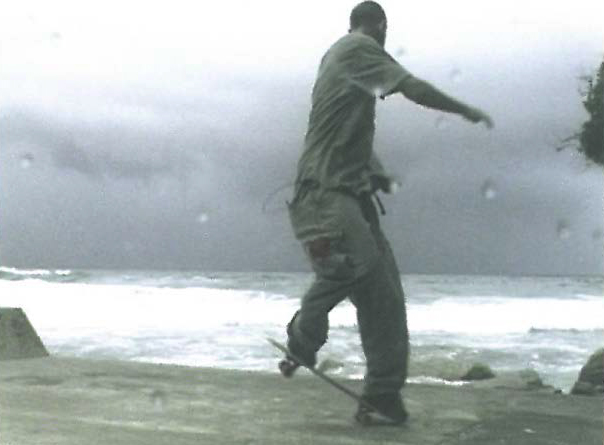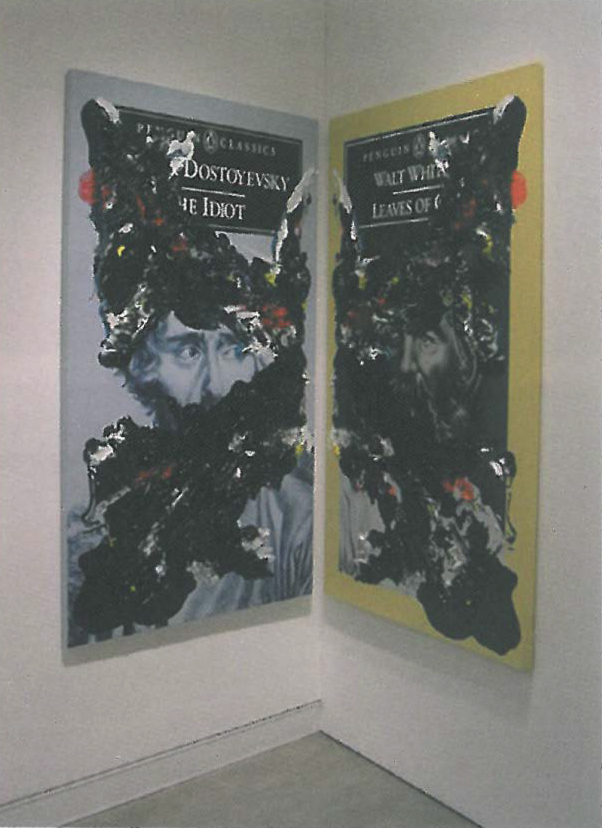
In the early 1990s when I was on the judging panel for the NSW Travelling Art Scholarship, amid the chaos of the entries from a multitude of young artists there were two paintings of precise order that stood out from the pack. They were meticulously painted giant copies of Penguin paperback editions of classic novels. They were by Shaun Gladwell. A decade later. Gladwell is still painting versions of Penguin classics, but now his message is more focussed. His Bipolar Butterfly series show paint bursting in a tangled butterfly pattern from those very same covers, made either of actual books or, in the case of Bi-polar Butterfly: classic scale version, large paintings harking back to his student days.
This diptych however holds a clue, both to this series and to the contrarian sense that colours much of Gladwell's oeuvre. The two titles chosen for the paint treatment are Dostoyevski's The Idiot and Walt Whitman's Leaves of Grass. Both are giants of their respective culture's literature. Both helped formulate their nation's self-image – Dostoyevsky's critical analysis versus Whitman's easily parodied optimism. Yet both are seen as classics of western civilisation.
Gladwell likes playing with contrasts and absurd commonalities. He made the leap from painter of book covers to fashionable young artist around town with videos of his virtuoso performances on skateboard. The running gag here is water. There is a sense of the melding of surfboard and skateboard, where water is linked with the concrete surface but the eye is constantly drawn to the elegant twisting figure of the artist as he controls his piece of floating curved wood.

In Storm Sequence, surely one of the most beautiful videos made in Australia, he twists the viewer's understanding even further. Gladwell the skateboarder elegantly twists and turns on the wet foreshore of a grey ocean beach. The mood is winter rain, almost poetic depression. The artist wears muted tones as he performs his elaborate dance of counterpoint on wheels. This is an urban skateboarder, performing a ritual that belongs to urban youth culture. But then the viewer recognises the beach, and all vision takes a backflip. The subject is readily identified as Coogee Beach, the site of Tom Roberts' and Charles Conder's great celebrations of sunshine and blue sky nationalism. But that was in 1888, a long time ago. Now artists select their compositions by aiming video cameras under cars to capture apparently accidental visions of themselves. Gladwell does this in Planet and Stars sequence which records his performance as a footpath spray painter in a video screened from the bottom of a trolley of the materials used in the video. Next to it hangs the elegant composition created on the footpath. Image and reality blur.
The essentially urban nature of Gladwell's vision is reinforced in Tangara, where he is apparently performing an elaborate routine in an upside down train. Of course the video is shot upside down and Gladwell himself was reversed, moving his feet in rhythm to an imaginary board. The total effect is of a skyboarder, a man suspended in an interurban machine, defying gravity and logic.
For all his interest in the fashionable forms of video and performance, Gladwell has not lost his interest in making objects as art. Enterprise melds the archaic and the modern, the fanciful and the prosaic, the legal drug and the nominally illegal substance. On a classic black coffee table he has placed a glass ashtray (tobacco is still legal) and a magnificently obscure bong made from toy plastic models of the Starship Enterprise from Startrek. Presumably this is so the smoker can 'go where no man has ever gone before'. The contrast could not be more delicious.
As well as visual, Gladwell's work moves to audio, playing with a sound mix made with Wade Marinowski, presented with a computer, using a vacuum cleaner. This all makes sense with the work he has done with the techno rock group, the Avalanches. Avalanches: Electricity Mix counters a deliberately archaic illustrative style against bursts of luminous paint – the artist is again spoofing the world in which he works.












